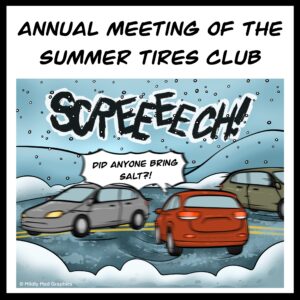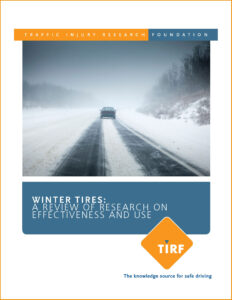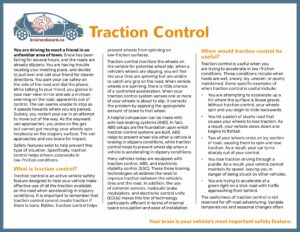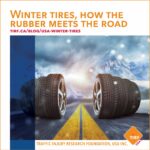It’s not just about snowfall…once temperatures dip to +7°C, winter tires help keep you safe on the road.
 Long, cold, snowy winters are familiar to most Canadians (and those other places across the globe who experience the onslaught of colder temperatures and winter whiteouts). But those adventures might be less familiar to those who would typically head to warmer climates this time of year.
Long, cold, snowy winters are familiar to most Canadians (and those other places across the globe who experience the onslaught of colder temperatures and winter whiteouts). But those adventures might be less familiar to those who would typically head to warmer climates this time of year.
While cross-border travel between Canada and the US has declined in recent months winter driving conditions may come as a bit of a surprise to those snowbirds and even some long-time residents.
When is it time to put on winter tires?

A top consideration for anyone looking to safely navigate Canada’s roads this winter is knowing the conversation has shifted (language-wise) from snow tires to winter tires. These terms do, in fact, refer to the same tire, but language has shifted to ensure consumers know not to wait for snow to get the right tires.
It’s actually weather temperatures that dictate when it’s time to store those summer tires. Once temperatures dip below +7°C, winter tires provide superior tire performance compared to summer and even all-season tires.
Does where I live dictate whether winter tires are actually needed?
Whether you’re a stranded snowbird or a winter weather expert, Canada is a large country with lots of different weather coast to coast. Based on the annual avalanche of east coast versus west coast #snowstorm memes, each province has an entirely different experience when it comes to winter weather. Vancouver’s, But, it’s a wet cold?! cannot be compared to Montrealers shovelling through 4 feet of packed snow deposited by the local snow plough just before leaving for work, and then shovelling all over again before being able to pull back into the driveway at the end of the day. In fact, it often becomes a friendly competition and point of pride to boast which province lays claim to the biggest snowfall of the season.
But, while each of us experiences unique winters depending on where we live or hang our hat this season, the summer to winter tire transition is relevant across the nation. And, yes, this is even true for Vancouver Islanders navigating the Malahat or waking up to the horror of significant and unexpected snowfall (remember Snowmageddon 2019?).
From St. John’s to Vancouver, expect the unexpected becomes more than a catchy phrase as drivers look forlornly between their summer tires or all seasons and the rising snowfall while strategizing how to get to work or the store. Many discover the hard way that not all all-seasons are actually for ALL seasons if they don’t have the coveted snowflake rating as found with winter tires or at least an M+S (Mud + Snow) rating which, by the way, is still not as effective as a complete winter tire. So, what’s the best choice and why?
Safe Winter Driving Starts with Winter Tires infographic

Our winter tire infographic answers some of the common questions about why winter driving requires winter tires and most importantly, why winter tires will help you get home safely.
It’s imperative drivers understand winter tires improve traction, but drivers must still drive according to weather & road conditions. A University of Michigan report found, “A two-wheel drive vehicle with winter tires will outperform a four-wheel drive vehicle with all-season tires in braking and cornering.”
Facts about winter tires versus all-season and summer tires
- Winter tire performance is superior in temperatures below +7°C (yes, that’s PLUS SEVEN) compared to all-season and summer tires.
- Winter tires use a rubber compound that is less stiff & more flexible in colder temperatures.
Winter tires have better traction at -30°C than all-season tires do at +4°C.
- Treads have deeper grooves and irregular edges to improve traction on wet, slushy, snowy, icy & dry cold surfaces.
- A car with winter tires on an icy road needs 6.4 metres to stop compared to 12.1 metres for a car with all-season tires.
- Winter tires are important because crash-avoidance technologies such as electronic stability control don’t work if tires have inadequate traction.
- The superior performance of winter tires during winter conditions increases the likelihood drivers can avoid a costly collision.
When it comes time to book your vehicle in the shop for the switch to winter tires, be sure to put on a complete set of winter tires because mixing different types of tires can cause a vehicle to fishtail. I think we can all agree that the only fishtails we want to see are those happily splashing around at the lake when we welcome Spring.
Download & share this free infographic produced in partnership with the Tire and Rubber Association of Canada:
#MySafeRoadHome blog co-authors: Karen Bowman, Director, Communications & Programs (Drop It And Drive® program) and Ward Vanlaar, TIRF COO, work collaboratively as co-authors. Karen has led the DIAD program since 2010 which, to date, has been delivered to over 65,000 youth and workers across North America. She uses her writing and blogging background to help apply TIRF’s research to real-world driving. She has also experienced the diversity of winter in the UK, Montreal, Ottawa, Victoria, Vancouver, the Kootenays and now, Nanaimo. Ward is a statistician and criminologist whose main fields of interest are traffic enforcement issues, risky driving behaviours, young and senior drivers, statistics and methodology, data management, safety performance indicators, and implementation of road safety programs. Originating from Ghent, Belgium and having lived in Ottawa, Ontario, for years before recently relocating to Vancouver Island, BC, Ward is accustomed to the rigours of winter driving; he not only loves winter but also enjoys winter driving.
Related topics:
 |
 |
 |
 |
Source documents & resources:
Galloway, M. (Host). (2024, December 11). Should winter tires be mandatory across Canada? [Audio podcast episode]. In The Current. Canadian Broadcasting Corporation. Should winter tires be mandatory across Canada? [Featuring TIRF President & CEO, Robyn Robertson]
Traffic Injury Research Foundation. (2025). Traction control [Fact sheet]. Brain on Board. https://brainonboard.ca/safety-features/traction-control/
Traffic Injury Research Foundation. (2020, November 2). Safe winter driving starts with winter tires [Infographic]. https://tirf.ca/download/safe-winter-driving-winter-tires
Woodroofe, John (2016). Ten Surprising Findings About Winter Tires: It Is Not Just About Snow, University of Michigan
Brown, S.W., Vanlaar, W.G.M., Robertson, R.D. (2012). Winter Tires: A Review of Research on Effectiveness and Use. Ottawa, Ontario: Traffic Injury Research Foundation. https://tirf.ca/TIRFCAD12G
Lawrence, J. (2019, February 12). So much snow has fallen in Victoria, it’s broken a record. CTV News. Retrieved November 3, 2025, from https://www.ctvnews.ca/vancouver/vancouver-island/article/so-much-snow-has-fallen-in-victoria-its-broken-a-record/
Partnership opportunity

Our 2012 winter tire report is featured annually by top media outlets. The average advertising value equivalency (AVE) for 2023 and 2024 exceeded $40.5 million. The media annually request more current research, so to ensure current data is available, we’ve included this topic in our 2025 Road Safety Monitor annual poll. Your support would fund a new winter tire publication and spin-off products including an infographic, blog, fact sheet and vodcast.
Donor support will be prominently acknowledged in the updated winter tire materials giving organizations the opportunity to align their brand’s safety profile with a cause that resonates with millions of individuals across the country. Learn more in our partnership information package.

 Winter tires have better traction at -30°C than all-season tires do at +4°C.
Winter tires have better traction at -30°C than all-season tires do at +4°C.

